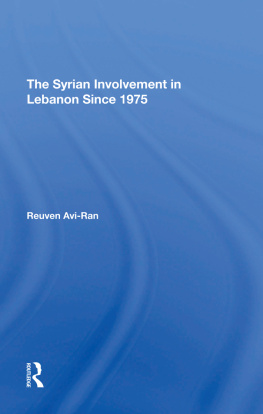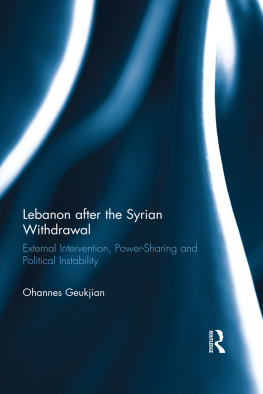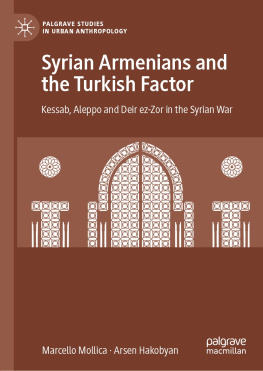The Syrian Involvement in Lebanon Since 1975
Studies in International Politics
The Leonard Davis Institute for International Relations The Hebrew University, Jerusalem
The Syrian Involvement in Lebanon Since 1975, Reuven Avi-Ran
Africa and Israel: Relations tn Perspective, Olusola Ojo
The Illusion of Deterrence: The Roosevelt Presidency and the Origins of the Pacific War, Abraham Ben-Zvi
Europe's Middle East Dilemma: The Quest for a Unified Stance, Ilan Greilsammer and Joseph Weiler
Dynamics of Dependence: U.S.-Israeli Relations, edited by Gabriel Sheffer
Jordan's Palestinian Challenge, 1948-1983: A Political History, Clinton Bailey
STUDIES IN INTERNATIONAL POLITICS, THE LEONARD DAVIS INSTITUTE FOR INTERNATIONAL RELATIONS, THE HEBREW UNIVERSITY, JERUSALEM
The Syrian Involvement in Lebanon Since 1975
Reuven Avi-Ran
Translated from the Hebrew by
David Maisel
First published 1991 by Westview Press
Published 2019 by Routledge
52 Vanderbilt Avenue, New York, NY 10017
2 Park Square, Milton Park, Abingdon, Oxon OX14 4RN
Routledge is an imprint of the Taylor & Francis Group, an informa business
Copyright 1991 by Taylor & Francis
All rights reserved. No part of this book may be reprinted or reproduced or utilised in any form or by any electronic, mechanical, or other means, now known or hereafter invented, including photocopying and recording, or in any information storage or retrieval system, without permission in writing from the publishers.
Notice:
Product or corporate names may be trademarks or registered trademarks, and are used only for identification and explanation without intent to infringe.
Library of Congress Cataloging-in-Publication Data
Avi-Ran, R.
[Me'oravut ha-Surit bi-Levanon (1975-1985). English]
The Syrian involvement in Lebanon since 1975 / by Reuven Avi-Ran.
p. cm. (Studies in international politics)
Translation of: ha-Me'oravut ha-Surit bi-Levanon (1975-1985).
Includes bibliographical references and index.
ISBN 0-8133-7935-0
1. LebanonMilitary relationsSyria. 2. SyriaMilitary
relationsLebanon. 3. SyriaHistory, Military. 4. Lebanon
History1975- . I. Title. II. Series: Studies in international
politics (Boulder, Colo.)
DS80.96.S9A85 1991
956.9204'4dc20 90-28789
CIP
ISBN 13: 978-0-367-29643-8 (hbk)
In April 1975, a civil war broke out in Lebanon which destroyed the traditional structure of the Lebanese state and society and produced a new crisis in Lebanon and the whole of the Middle East which has lasted until the present day. Syria was drawn into this crisis, at first in the role of an intermediary between the rival factions and later as a party directly involved in the Lebanese conflict. This involvement increased until it led to a massive Syrian military intervention and a continuous expenditure of political effort and military and diplomatic resources over a decade in an attempt to impose Syrian hegemony on Lebanon, and to use the Lebanese crisis as a means of promoting the objectives of the Assad regime in the Arab world and in the struggle against Israel.
This book is the first attempt at a comprehensive examination of the Syrian involvement in the Lebanese crisis. Among the subjects treated are the Syrian interests in Lebanon, the motivation of the Assad regime for intervening in the Lebanese crisis, the pattern of Syrian actions in Lebanon, Syria's relationship with the Lebanese power factions, the Syrian-Israeli rivalry for influence in Lebanon, and the various factors which influenced Syrian policies in Lebanon. We shall also consider the effects of the Syrian intervention in Lebanon on the stability of the Assad regime, on Syria's position in the Arab world, and on its capability of action in the Arab-Israeli conflict.
The terminology used in connection with the Lebanese crisis has been subject to dispute. Thus, for example, the term "Lebanese civil war" used in this book is not accepted by the Christian leaders in Lebanon, who claim that the events of the years 1975-1976 mainly represented a conflict between Lebanese and Palestinians. However, the fighting which began in April 1975 and ended with the Riyadh and Cairo Conference (October 1976) may nevertheless be regarded as a civil war in all respects, for it was essentially the product of a deep-rooted intercommunal hostility and in its first stages (until the beginning of 1976) was mainly confined to the rival Lebanese factions. The term "Lebanese crisis" refers to the period beginning in April 1975 and lasting until the present day, which has been marked by outbreaks of intermittent fighting between the rival Lebanese factions against a background of active intervention by external forces such as the Palestinian organizations, Syria, Israel, inter-Arab forces, and international forces. Even more problematic are terms such as "left" and "right," the "Muslim camp" and the "Christian camp," used to describe the complexities and the shades of difference of the rival factions in Lebanon. In all cases where I have used general terms of this kind, I have tried to define the nature of the entities which these terms refer to.
In view of the absence of an academic literature dealing with all aspects of the Syrian involvement in Lebanon over the last decade, this study has been based mainly on firsthand sources. These include the Syrian, Lebanese, and Palestinian press and other Arab newspapers, as well as Arab radio broadcasts and the reports of the Arab and Western news agencies on the Lebanese crisis. In addition, in recent years the memoirs have appeared of Lebanese and Palestinian figures who played a key role in the Lebanese crisis, and these provide a valuable source for an understanding of Syrian actions in Lebanon. I was afforded an insight into the part played by Israel and the United States in Syrian policies in Lebanon by the interviews granted me by Yitzhak Rabin, prime minister of Israel in 1974-1977, Simcha Dinitz, Israeli ambassador to Washington in 1973-1978, Mordechai Gur, Israel Defense Forces (IDF) chief of staff in 1974-1978, and others.
Reuven Avi-Ran
Introduction: Origins of the Syrian Involvement in Lebanon
Historical Origins of the Concept of the Unity of Syria and Lebanon
In Arab-Muslim historical geography, the Syria and Lebanon of today formed part of a region called bilad al-Sham, or "the land of the north" that is, the area to the north of the Arabian Peninsula, whose boundaries were the Taurus Mountains to the north, the Hejaz, the Gulf of Eilat, and the Sinai Peninsula to the south, the Tigris and Euphrates to the east, and the Mediterranean to the west. This region constituted a separate territorial-political unit under the rule of the House of Ummayya (661-750), and from then until the beginning of the twentieth century was part of various empires whose centers lay outside its boundaries. In the second half of the nineteenth century, a handful of young Christians in Beirut and Damascus, progenitors of the Arab national movement, gave the term bilad al-Sham and the ancient name Syria (whose origin was Hellenistic) a new, political significance. Following the massacre of Christians in Lebanon and Damascus in 1860, these people saw the solution to the problem of the Christian community in the replacement of the religious communal allegiances which fragmented the population with a secular Syrian patriotism based on language, culture, history, and an allegiance to the Syrian motherland. They regarded Lebanon as forming part of a larger Syrian entity, and the first Arab political platform, which was drawn up by a secret society of young Christians in Beirut in 1875, spoke specifically of "the grant of independence to Syria, in union with Lebanon" in Mount Lebanon, which preferred to continue to remain segregated from the Muslims by the communal framework and foreign protection which were embodied in the transformation of Mount Lebanon in 1861 into an autonomous province of the section of the Ottoman Empire controlled by the European powers.











